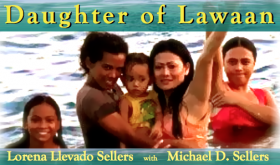A year ago Rena and I began a project which we called “Daughter of Lawaan” — the story, as told by Rena, of what it was like to be a child growing up in Eastern Samar, the daughter of a fisherman in a seaside barrio, Guinob-an, that to me has always seemed like something out of a storybook.
During her childhood the town had no road in, no road out — the only access was by sea; no electricity; no running water; and the only consistent contact with what we generally think of as the “outside world” was a transistor radio which, because the battery had to be preserved, was used mainly for weather reports to ensure it was safe for her father and brothers to go fishing. Rena was the youngest of 12 children, and her story is to me, a compelling combination of idyllic, exotic, and adventurous. When I think of her journey it occurs to me that she has experienced greater changes in her life in 30-something years than people in my family have experienced in four generations.
Hers is a tale of running down to the sea each day to get the leftovers from her father’s baon as he returned from marlin fishing; of hiking an hour up into the forest with her mother to tend the root crops in the family plot; of walking through the town calling out “isda”, selling fish to the neighbors; of innocently slipping into the back of the room with the adults to and hear the song and dance presentations of the communist guerrillas who would visit the town; of living in fear during martial law that her brothers of father might be taken and never come back; and of sleeping at dusk and waking at dawn except during the full moon, when the moonlight created a magical playtime for the children of Guinob-an.
Lately, as I’ve been writing frequently about the Philippines, a number of people — many from Lawaan and Eastern Samar — seem to be discovering her unfinished story and asking when we will finish it. Maybe it’s time to resume. Our process is for me to record a detailed interview with Rena, asking every question I can think of as she tells her story. Then I compile a transcript of the interview, which she edits. Then I edit that, and she has final approval — so it’s a multi-step process. The reminiscence that is emerging is geniune and heartfelt, in Rena’s voice, and is something that I want our kids, and their kids, and the ones that follow them, to have access to so they know their heritage.
Thank you to everyone who has provided encouragement for this — your kind words inspire, and as the holidays approach, I hope that I hope I will be able to coax Rena into sitting down for more sessions that will yield the balance of her story.
Meanwhile — here is what we have so far:
PROLOGUE
Before We Begin
Origins of Lawaan
An American Colony?
MY STORY
My Parents, Before I Was Born
My Earliest Childhood, Two Near Tragedies
Life Under Martial Law
Oh, and I can’t resist sharing this. Lawaan has come a long way — as evidenced by the fact that the Binibining Lawaan pageant has its very own theme song and music video — now cool is that? I know my home town sure doesn’t have something like that, and it’s a lovely song — Destiny’s Ticket, sung with grace and beauty: (and remember — Lawaan is the municipality, and Guinob-an where Rena grew up is one of it’s barangays….) the video is presented by BLUE — Binibining Lawaan Unified Enthusiasts…..and is posted by Youtuber Webman101 — thank you! (And if I’m not mistaken, Webman101 is Neil Tenefrancia, the writer of the song……who is also the person behind the very much appreciated http://lawaan.com. Thanks!)
And as if that’s not enough, Webman101 also has this “Opening Billboard” video for Lawaan Idol…..I can’t tell you how much I love this stuff! Thank you Webman101!
